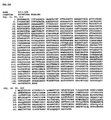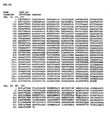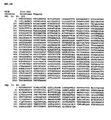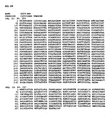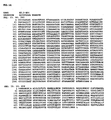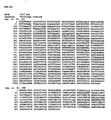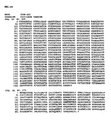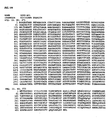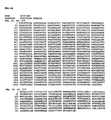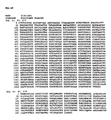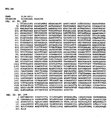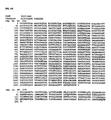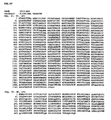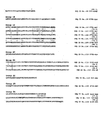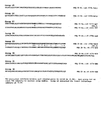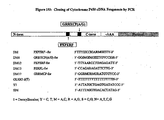EP2204444A1 - Klonen von Cytochrom P450-Genen aus Nikotiana - Google Patents
Klonen von Cytochrom P450-Genen aus Nikotiana Download PDFInfo
- Publication number
- EP2204444A1 EP2204444A1 EP10000366A EP10000366A EP2204444A1 EP 2204444 A1 EP2204444 A1 EP 2204444A1 EP 10000366 A EP10000366 A EP 10000366A EP 10000366 A EP10000366 A EP 10000366A EP 2204444 A1 EP2204444 A1 EP 2204444A1
- Authority
- EP
- European Patent Office
- Prior art keywords
- seq
- nucleic acid
- amino acid
- plant
- identity
- Prior art date
- Legal status (The legal status is an assumption and is not a legal conclusion. Google has not performed a legal analysis and makes no representation as to the accuracy of the status listed.)
- Ceased
Links
Images
Classifications
-
- C—CHEMISTRY; METALLURGY
- C12—BIOCHEMISTRY; BEER; SPIRITS; WINE; VINEGAR; MICROBIOLOGY; ENZYMOLOGY; MUTATION OR GENETIC ENGINEERING
- C12N—MICROORGANISMS OR ENZYMES; COMPOSITIONS THEREOF; PROPAGATING, PRESERVING, OR MAINTAINING MICROORGANISMS; MUTATION OR GENETIC ENGINEERING; CULTURE MEDIA
- C12N15/00—Mutation or genetic engineering; DNA or RNA concerning genetic engineering, vectors, e.g. plasmids, or their isolation, preparation or purification; Use of hosts therefor
- C12N15/09—Recombinant DNA-technology
- C12N15/63—Introduction of foreign genetic material using vectors; Vectors; Use of hosts therefor; Regulation of expression
- C12N15/79—Vectors or expression systems specially adapted for eukaryotic hosts
- C12N15/82—Vectors or expression systems specially adapted for eukaryotic hosts for plant cells, e.g. plant artificial chromosomes (PACs)
- C12N15/8241—Phenotypically and genetically modified plants via recombinant DNA technology
- C12N15/8242—Phenotypically and genetically modified plants via recombinant DNA technology with non-agronomic quality (output) traits, e.g. for industrial processing; Value added, non-agronomic traits
- C12N15/8243—Phenotypically and genetically modified plants via recombinant DNA technology with non-agronomic quality (output) traits, e.g. for industrial processing; Value added, non-agronomic traits involving biosynthetic or metabolic pathways, i.e. metabolic engineering, e.g. nicotine, caffeine
-
- C—CHEMISTRY; METALLURGY
- C12—BIOCHEMISTRY; BEER; SPIRITS; WINE; VINEGAR; MICROBIOLOGY; ENZYMOLOGY; MUTATION OR GENETIC ENGINEERING
- C12N—MICROORGANISMS OR ENZYMES; COMPOSITIONS THEREOF; PROPAGATING, PRESERVING, OR MAINTAINING MICROORGANISMS; MUTATION OR GENETIC ENGINEERING; CULTURE MEDIA
- C12N15/00—Mutation or genetic engineering; DNA or RNA concerning genetic engineering, vectors, e.g. plasmids, or their isolation, preparation or purification; Use of hosts therefor
- C12N15/09—Recombinant DNA-technology
- C12N15/11—DNA or RNA fragments; Modified forms thereof; Non-coding nucleic acids having a biological activity
- C12N15/52—Genes encoding for enzymes or proenzymes
-
- C—CHEMISTRY; METALLURGY
- C12—BIOCHEMISTRY; BEER; SPIRITS; WINE; VINEGAR; MICROBIOLOGY; ENZYMOLOGY; MUTATION OR GENETIC ENGINEERING
- C12N—MICROORGANISMS OR ENZYMES; COMPOSITIONS THEREOF; PROPAGATING, PRESERVING, OR MAINTAINING MICROORGANISMS; MUTATION OR GENETIC ENGINEERING; CULTURE MEDIA
- C12N15/00—Mutation or genetic engineering; DNA or RNA concerning genetic engineering, vectors, e.g. plasmids, or their isolation, preparation or purification; Use of hosts therefor
- C12N15/09—Recombinant DNA-technology
- C12N15/11—DNA or RNA fragments; Modified forms thereof; Non-coding nucleic acids having a biological activity
-
- C—CHEMISTRY; METALLURGY
- C12—BIOCHEMISTRY; BEER; SPIRITS; WINE; VINEGAR; MICROBIOLOGY; ENZYMOLOGY; MUTATION OR GENETIC ENGINEERING
- C12N—MICROORGANISMS OR ENZYMES; COMPOSITIONS THEREOF; PROPAGATING, PRESERVING, OR MAINTAINING MICROORGANISMS; MUTATION OR GENETIC ENGINEERING; CULTURE MEDIA
- C12N9/00—Enzymes; Proenzymes; Compositions thereof; Processes for preparing, activating, inhibiting, separating or purifying enzymes
- C12N9/0004—Oxidoreductases (1.)
- C12N9/0071—Oxidoreductases (1.) acting on paired donors with incorporation of molecular oxygen (1.14)
- C12N9/0077—Oxidoreductases (1.) acting on paired donors with incorporation of molecular oxygen (1.14) with a reduced iron-sulfur protein as one donor (1.14.15)
Definitions
- the present invention relates to nucleic acid sequences encoding cytochrome p450 enzymes (hereinafter referred to as p450 and p450 enzymes) in Nicotiana plants and methods for using those nucleic acid sequences to alter plant phenotypes.
- p450 and p450 enzymes cytochrome p450 enzymes
- Cytochrome p450s catalyze enzymatic reactions for a diverse range of chemically dissimilar substrates that include the oxidative, peroxidative and reductive metabolism of endogenous and xenobiotic substrates.
- p450s participate in biochemical pathways that include the synthesis of plant products such as phenylpropanoids, alkaloids, terpenoids, lipids, cyanogenic glycosides, and glucosinolates ( Chappel, Annu. Rev. Plant Physiol. Plant Mol. Biol. 198, 49:311-343 ).
- Cytochrome p450s also known as p450 heme-thiolate proteins, usually act as terminal oxidases in multicomponent electron transfer chains, called p450-containing monooxygenase systems. Specific reactions catalyzed include demethylation, hydroxylation, epoxidation, N-oxidation, sulfooxidation, N-, S-, and O-dealkylations, desulfation, deamination, and reduction of azo, nitro, and N-oxide groups.
- Nicotiana plant p450 enzymes have been implicated in effecting a variety of plant metabolites such as phenylpropanoids, alkaloids, terpenoids, lipids, cyanogenic glycosides, glucosinolates and a host of other chemical entities.
- plant metabolites such as phenylpropanoids, alkaloids, terpenoids, lipids, cyanogenic glycosides, glucosinolates and a host of other chemical entities.
- some p450 enzymes can impact the composition of plant metabolites in plants. For example, it has been long desired to improve the flavor and aroma of certain plants by altering its profile of selected fatty acids through breeding; however very little is known about mechanisms involved in controlling the levels of these leaf constituents.
- the down regulation of p450 enzymes associated with the modification of fatty acids may facilitate accumulation of desired fatty acids that provide more preferred leaf phenotypic qualities.
- p450 enzymes The function of p450 enzymes and their broadening roles in plant constituents is still being discovered. For instance, a special class of p450 enzymes was found to catalyze the breakdown of fatty acid into volatile C6- and C9-aldehydes and -alcohols that are major contributors of "fresh green" odor of fruits and vegetables.
- the level of other novel targeted p450s may be altered to enhance the qualities of leaf constituents by modifying lipid composition and related break down metabolites in Nicotiana leaf. Several of these constituents in leaf are affected by senescence that stimulates the maturation of leaf quality properties. Still other reports have shown that p450s enzymes are play a functional role in altering fatty acids that are involved in plant-pathogen interactions and disease resistance.
- p450 enzymes have been suggested to be involved in alkaloid biosynthesis.
- Nornicotine is a minor alkaloid found in Nicotiana tabaceum . It has been postulated that it is produced by the p450 mediated demethylation of nicotine followed by acylation and nitrosation at the N position thereby producing a series of N-acylnonicotines and N-nitrosonornicotines.
- N-demethylation catalyzed by a putative p450 demethylase, is thought to be a primary source of nornicotine biosyntheses in Nicotiana. While the enzyme is believed to be microsomal, thus far a nicotine demethylase enzyme has not been successfully purified, nor have the genes involved been isolated.
- the activity of p450 enzymes is genetically controlled and also strongly influenced by environment factors. For example, the demethylation of nicotine in Nicotiana is thought to increase substantially when the plants reach a mature stage. Furthermore, it is hypothesized yet not proven that the demethylase gene contains a transposable element that can inhibit translation of RNA when present.
- the present invention is directed to plant p450 enzymes.
- the present invention is further directed to plant p450 enzymes from Nicotiana .
- the present invention is also directed to p450 enzymes in plants whose expression is induced by ethylene and/or plant senescence.
- the present invention is yet further directed to nucleic acid sequences in plants having enzymatic activities, for example, being categorized as oxygenase, demethylase and the like, or other and the use of those sequences to reduce or silence the expression or over-expression of these enzymes.
- the invention also relates to p450 enzymes found in plants containing higher nornicotine levels than plants exhibiting lower nornicotine levels.
- the invention is directed to nucleic acid sequences as set forth in SEQ. ID. Nos. 1, 3, 5, 7, 9, 11, 13, 15, 17, 19, 21, 23, 25, 27, 29, 31, 33, 35, 37, 39, 41, 43, 45, 47, 49, 51, 53, 55, 57, 59, 61, 63, 65, 67, 69, 71, 73, 75, 77, 79, 81, 83, 85, 87, 89, 91, 95, 97, 99, 101, 103, 105, 107, 109, 111, 113, 115, 117, 119, 121, 123, 125, 127, 129, 131, 133, 135, 137, 139, 143, 145, 147, 149, 151, 153, 155, 157, 159, 161, 163, 165, 167, 169, 171, 173, 175, 177, 179, 181, 183, 185, 187, 189, 191, 193, 195
- those fragments containing greater than 75% identity in nucleic acid sequence were placed into groups dependent upon their identity in a region corresponding to the first nucleic acid following the cytochrome p450 motif GXRXCX(G/A) to the stop codon.
- the representative nucleic acid groups and respective species are shown in Table I.
- the invention is directed to amino acid sequences as set forth in SEQ. ID. Nos. 2, 4, 6, 8, 10, 12, 14, 16, 18, 20, 22, 24, 26, 28, 30, 32, 34, 36, 38, 40, 42, 44, 46, 48, 50, 52, 54, 56, 58, 60, 62, 64, 66, 68, 70, 72, 74, 76, 78, 80, 82, 84, 86, 88, 90, 92, 96, 98, 100, 102, 104, 106, 108, 110, 112, 114, 116, 118, 120, 122, 124, 126, 128, 130, 132, 134, 136, 138, 140, 144, 146, 148, 150, 152, 154, 156, 158, 160, 162, 164, 166, 168, 170, 172, 174, 176, 178, 180, 182, 184, 186, 188, 190, 192, 194, 196, 198
- those fragments containing greater than 71% identity in amino acid sequence were placed into groups dependent upon their identity to each other in a region corresponding to the first amino acid following the cytochrome p450 motif GXRXCX(G/A) to the stop codon.
- the representative amino acid groups and respective species are shown in Table II.
- the invention is directed to amino acid sequences of full length genes as set forth in SEQ. ID. Nos. 150, 152, 154, 156, 158, 160, 162, 164, 166, 168, 170, 172, 174, 176, 178, 180, 182, 184, 186, 188, 190, 192, 194, 196, 198, 200, 202, 204, 206, 208, 210, 212, 214, 216, 218, 220, 222, 224, 226, 228, 230, 232, 234, 236, 238, 240, 242, 244, 246, 248, 250, 252, 254, 256, 258, 260, 262, 264, 266, 268, 270, 272, 274, 276, 278, 280, 282, 284, 286, 288, 290, 292, 294, 296 and 298.
- the invention is directed to amino acid sequences of the fragments set forth in SEQ. ID. Nos. 299-357.
- those fragments containing 90% or greater identity in amino acid sequence were placed into groups dependent upon their identity to each other in a region corresponding to the first cytochrome p450 domain, UXXRXXZ, to the third cytochrome domain, GXRXO, where U is E or K, X is any amino acid and' Z is R, T, S or M.
- the representative amino acid groups respective species shown in Table IV.
- the reduction or elimination or over-expression of p450 enzymes in Nicotiana plants may be accomplished transiently using RNA viral systems.
- Resulting transformed or infected plants are assessed for phenotypic changes including, but not limited to, analysis of endogenous p450 RNA transcripts, p450 expressed peptides, and concentrations of plant metabolites using techniques commonly available to one having ordinary skill in the art.
- the present invention is also directed to generation of trangenic Nicotiana lines that have altered p450 enzyme activity levels.
- these transgenic lines include nucleic acid sequences that are effective for reducing or silencing or increasing the expression of certain enzyme thus resulting in phenotypic effects within Nicotiana.
- nucleic acid sequences include SEQ. ID. Nos.
- plant cultivars including nucleic acids of the present invention in a down regulation capacity using either full length genes or fragments thereof or in an over-expression capacity using full length genes will have altered metabolite profiles relative to control plants.
- plant cultivars including nucleic acid of the present invention using either full length genes or fragments thereof in modifying the biosynthesis or breakdown of metabolites derived from the plant or external to the plants will have use in tolerating certain exogenous chemicals or plant pests.
- nucleic acid sequences include SEQ ID. Nos.
- the present invention is directed to the screening of plants, more preferably Nicotiana, that contain genes that have substantial nucleic acid identity to the taught nucleic acid sequence.
- the use of the invention would be advantageous to identify and select plants that contain a nucleic acid sequence with exact or substantial identity where such plants are part of a breeding program for traditional or transgenic varieties, a mutagenesis program, or naturally occurring diverse plant populations.
- the screening of ants for substantial nucleic acid identity may be accomplished by evaluating plant nucleic acid materials using a nucleic acid probe in conjunction with nucleic acid detection protocols including, but not limited to, nucleic acid hybridization and PCR analysis.
- the nucleic acid probe may consist of the taught nucleic acid sequence or fragment thereof corresponding to SEQ ID 1, 3, 5, 7, 9, 11, 13, 15, 17, 19, 21, 23, 25, 27, 29, 31, 33, 35, 37, 39, 41, 43, 45, 47, 49, 51, 53, 55, 57, 59, 61, 63, 65, 67, 69, 71, 73, 75, 77, 79, 81, 83, 85, 87, 89, 91, 95, 97, 99, 101, 103, 105, 107, 109, 111, 113, 115, 117, 119, 121, 123, 125, 127, 129, 131, 133, 135, 137, 139, 143, 145, 147, 149, 151, 153, 155, 157, 159, 161, 163, 165, 167, 169, 171, 173, 175, 177, 179, 181, 183, 185, 187, 189, 191, 193, 195,
- the present invention is directed to the identification of plant genes, more preferably Nicotiana, that share substantial amino acid identity corresponding to the taught nucleic acid sequence.
- the identification of plant genes including both cDNA and genomic clones, those cDNAs and genomic clones, more preferably from Nicotiana may be accomplished by screening plant cDNA libraries using a nucleic acid probe in conjunction with nucleic acid detection protocols including, but not limited to, nucleic acid hybridization and PCR analysis.
- the nucleic acid probe may be comprised of nucleic acid sequence or fragment thereof corresponding to SEQ ID 1, 3, 5, 7, 9, 11, 13, 15, 17, 19, 21, 23, 25, 27, 29, 31, 33, 35, 37, 39, 41, 43, 45, 47, 49, 51, 53, 55, 57, 59, 61, 63, 65, 67, 69, 71, 73, 75, 77, 79, 81, 83, 85, 87, 89, 91, 95, 97, 99, 101, 103, 105, 107, 109, 111, 113, 115, 117, 119, 121, 123, 125, 127, 129, 131, 133, 135, 137, 139, 143, 145 and 147.
- cDNA expression libraries that express peptides may be screened using antibodies directed to part or all of the taught amino acid sequence.
- amino acid sequences include SEQ ID 2, 4, 8, 9, 10, 12, 14, 16, 18, 20, 22, 24, 26, 28, 30, 32, 34, 36, 38, 40, 42, 44, 46, 48, 50, 52, 54, 56, 58, 60, 62, 64, 66, 68, 70, 72, 74, 76, 78, 80, 82, 84, 86, 88, 90, 92, 96, 98, 100, 102, 104, 106, 108, 110, 112, 114, 116, 118, 120, 122, 124, 126, 128, 130, 132, 134, 136, 138, 140, 144, 146, 148.
- the present invention is also directed to generation of transgenic Nicotiana lines that have over-expression of p450 enzyme activity levels.
- these transgenic lines include all nucleic acid sequences encoding the amino acid sequences of full length genes that are effective for increasing the expression of certain enzyme thus resulting in phenotypic effects within Nicotiana.
- amino acid sequences include SEQ. ID.
- nucleic acid refers to a deoxyribonucleotide or ribonucleotide polymer in either single- or double-stranded form, or sense or anti-sense, and unless otherwise limited, encompasses known analogues of natural nucleotides that hybridize to nucleic acids in a manner similar to naturally occurring nucleotides. Unless otherwise indicated, a particular nucleic acid sequence includes the complementary sequence thereof.
- operably linked refers to functional linkage between a nucleic acid expression control sequence (such as a promoter, signal sequence, or array of transcription factor binding sites) and a second nucleic acid sequence, wherein the expression control sequence affects transcription and/or translation of the nucleic acid corresponding to the second sequence.
- a nucleic acid expression control sequence such as a promoter, signal sequence, or array of transcription factor binding sites
- Recombinant when used with reference to a cell indicates that the cell replicates a heterologous nucleic acid, expresses said nucleic acid or expresses a peptide, heterologous peptide, or protein encoded by a heterologous nucleic acid.
- Recombinant cells can express genes or gene fragments in either the sense or antisense form that are not found within the native (non-recombinant) form of the cell.
- Recombinant cells can also express genes that are found in the native form of the cell, but wherein the genes are modified and re-introduced into the cell by artificial means.
- a “structural gene” is that portion of a gene comprising a DNA segment encoding a protein, polypeptide or a portion thereof, and excluding the 5' sequence which drives the initiation of transcription.
- the structural gene may alternatively encode a nontranslatable product.
- the structural gene may be one which is normally found in the cell or one which is not normally found in the cell or cellular location wherein it is introduced, in which case it is termed a "heterologous gene".
- a heterologous gene may be derived in whole or in part from any source known to the art, including a bacterial genome or episome, eukaryotic, nuclear or plasmid DNA, cDNA, viral DNA or chemically synthesized DNA.
- a structural gene may contain one or more modifications that could effect biological activity or its characteristics, the biological activity or the chemical structure of the expression product, the rate of expression or the manner of expression control. Such modifications include, but are not limited to, mutations, insertions, deletions and substitutions of one or more nucleotides.
- the structural gene may constitute an uninterrupted coding sequence or it may include one or more introns, bounded by the appropriate splice junctions.
- the structural gene may be translatable or non-translatable, including in an anti-sense orientation.
- the structural gene may be a composite of segments derived from a plurality of sources and from a plurality of gene sequences (naturally occurring or synthetic, where synthetic refers to DNA that is chemically synthesized).
- “Derived from” is used to mean taken, obtained, received, traced, replicated or descended from a source (chemical and/or biological).
- a derivative may be produced by chemical or biological manipulation (including, but not limited to, substitution, addition, insertion, deletion, extraction, isolation, mutation and replication) of the original source.
- “Chemically synthesized”, as related to a sequence of DNA, means that portions of the component nucleotides were assembled in vitro.
- Manual chemical synthesis of DNA may be accomplished using well established procedures ( Caruthers, Methodology of DNA and RNA Sequencing, (1983), Weissman (ed.), Praeger Publishers, New York, Chapter 1 ); automated chemical synthesis can be performed using one of a number of commercially available machines.
- Optimal alignment of sequences for comparison may be conducted by the local homology algorithm of Smith and Waterman, Adv. Appl. Math. 2:482 (1981 ), by the homology alignment algorithm of Needleman and Wunsch, J. Mol. Biol. 48:443 (1970 ), by the search for similarity method of Pearson and Lipman Proc. Natl. Acad. Sci. (U.S.A.) 85: 2444 (1988 ), by computerized implementations of these algorithms (GAP, BESTFIT, FASTA, and TFASTA in the Wisconsin Genetics Software Package, Genetics Computer Group, 575 Science Dr., Madison, Wis.), or by inspection.
- NCBI Basic Local Alignment Search Tool (Altschul et al., 1990) is available from several sources, including the National Center for Biological Information (NCBI, Bethesda, Md.) and on the Internet, for use in connection with the sequence analysis programs blastp, blastn, blastx, tblastn and tblastx. It can be accessed at htp://www.ncbi.nlm.nih.gov/BLAST/. A description of how to determine sequence identity using this program is available at http://www.ncbi.nlm.nih.gov/BLAST/blast help.html.
- substantially amino acid identity or “substantial amino acid sequence identity” as applied to amino acid sequences and as used herein denote a characteristic of a polypeptide, wherein the peptide comprises a sequence that has at least 70 percent sequence identity, preferably 80 percent amino acid sequence identity, more preferably 90 percent amino acid sequence identity, and most preferably at least 99 to 100 percent sequence identity as compared to a reference group over region corresponding to the first amino acid following the cytochrome p450 motif GXRXCX(G/A) to the stop codon of the translated peptide.
- nucleic acid identity or “substantial nucleic acid sequence identity” as applied to nucleic acid sequences and as used herein denote a characteristic of a polynucleotide sequence, wherein the polynucleotide comprises a sequence that has at least 75 percent sequence identity, preferably 81 percent amino acid sequence identity, more preferably at least 91 percent sequence identity, and most preferably at least 99 to 100 percent sequence identity as compared to a reference group over region corresponding to the first nucleic acid following the cytochrome p450 motif GXRXCX(G/A) to the stop codon of the translated peptide.
- stringent conditions are sequence-dependent and will be different in different circumstances.
- stringent conditions are selected to be about 5°C to about 20°C, usually about 10°C to about 15°C, lower than the thermal melting point (Tm) for the specific sequence at a defined ionic strength and pH.
- Tm is the temperature (under defined ionic strength and pH) at which 50% of the target sequence hybridizes to a matched probe.
- stringent conditions will be those in which the salt concentration is about 0.02 molar at pH 7 and the temperature is at least about 60°C.
- stringent conditions will include an initial wash in 6xSSC at 42 °C followed by one or more additional washes in 0.2xSSC at a temperature of at least about 55°C, typically about 60°C and often about 65°C.
- Nucleotide sequences are also substantially identical for purposes of this invention when the polypeptides and/or proteins which they encode are substantially identical. Thus, where one nucleic acid sequence encodes essentially the same polypeptide as a second nucleic acid sequence, the two nucleic acid sequences are substantially identical, even if they would not hybridize under stringent conditions due to degeneracy permitted by the genetic code (see, Darnell et al. (1990) Molecular Cell Biology, Second Edition Scientific American Books W. H. Freeman and Company New York for an explanation of codon degeneracy and the genetic code). Protein purity or homogeneity can be indicated by a number of means well known in the art, such as polyacrylamide gel electrophoresis of a protein sample, followed by visualization upon staining. For certain purposes high resolution may be needed and HPLC or a similar means for purification may be utilized.
- vector is used in reference to nucleic acid molecules that transfer DNA segment(s) into a cell.
- a vector may act to replicate DNA and may reproduce independently in a host cell.
- vector is sometimes used interchangeably with “vector.”
- expression vector refers to a recombinant DNA molecule containing a desired coding sequence and appropriate nucleic acid sequences necessary for the expression of the operably linked coding sequence in a particular host organism.
- Nucleic acid sequences necessary for expression in prokaryotes usually include a promoter, an operator (optional), and a ribosome binding site, often along with other sequences.
- Eucaryotic cells are known to utilize promoters, enhancers, and termination and polyadenylation signals.
- a nucleic acid may be inserted into plant cells, for example, by any technique such as in vivo inoculation or by any of the known in vitro tissue culture techniques to produce transformed plant cells that can be regenerated into complete plants.
- the insertion into plant cells may be by in vitro inoculation by pathogenic or non-pathogenic A. tumefaciens .
- Other such tissue culture techniques may also be employed.
- Plant tissue includes differentiated and undifferentiated tissues of plants, including, but not limited to, roots, shoots, leaves, pollen, seeds, tumor tissue and various forms of cells in culture, such as single cells, protoplasts, embryos and callus tissue.
- the plant tissue may be in planta or in organ, tissue or cell culture.
- Plant cell as used herein includes plant cells in planta and plant cells and protoplasts in culture.
- cDNA or “complementary DNA” generally refers to a single stranded DNA molecule with a nucleotide sequence that is complementary to an RNA molecule. cDNA is formed by the action of the enzyme reverse transcriptase on an RNA template.
- RNA was extracted from Nicotiana tissue of converter and non-converter Nicotiana lines. The extracted RNA was then used to create cDNA. Nucleic acid sequences of the present invention were then generated using two strategies.
- the poly A enriched RNA was extracted from plant tissue and cDNA was made by reverse transcription PCR.
- the single strand cDNA was then used to create p450 specific PCR populations using degenerate primers plus a oligo d(T) reverse primer.
- the primer design was based on the highly conserved motifs of p450. Examples of specific degenerate primers are set forth in Figure 1 . Sequence fragments from plasmids containing appropriate size inserts were further analyzed. These size inserts typically ranged from about 300 to about 800 nucleotides depending on which primers were used.
- a cDNA library was initially constructed.
- the cDNA in the plasmids was used to create p450 specific PCR populations using degenerate primers plus T7 primer on plasmid as reverse primer.
- sequence fragments from plasmids containing appropriate size inserts were further analyzed.
- Nicotiana plant lines known to produce high levels of nornicotine (converter) and plant lines having undetectable levels of nornicotine may be used as starting materials.
- Leaves can then be removed from plants and treated with ethylene to activate p450 enzymatic activities defined herein.
- Total RNA is extracted using techniques known in the art.
- cDNA fragments can then be generated using PCR (RT-PCR) with the oligo d(T) primer as described in Figure 153 .
- the cDNA library can then be constructed more fully described in examples herein.
- the conserved region of p450 type enzymes can be used as a template for degenerate primers ( Figure 75 ).
- degenerate primers p450 specific bands can be amplified by PCR. Bands indicative for p450 like enzymes can be identified by DNA sequencing. PCR fragments can be characterized using BLAST search, alignment or other tools to identify appropriate candidates.
- Sequence information from identified fragments can be used to develop PCR primers. These primers in combination of plasmid primers in cDNA library were used to clone full length p450 genes. Large-scale Southern reverse analysis was conducted to examine the differential expression for all fragment clones obtained and in some cases full length clones. In this aspect of the invention, these large-scale reverse Southern assays can be conducted using labeled total cDNA's from different tissues as a probe to hybridize with cloned DNA fragments in order to screen all cloned inserts.
- Nonradioactive and radioactive were also used to characterize clones p450 fragments and full length clones.
- Peptide specific antibodies were made against several full-length clones by deriving their amino acid sequence and selecting peptide regions that were antigenic and unique relative to other clones. Rabbit antibodies were made to synthetic peptides conjugated to a carrier protein. Western blotting analyses or other immunological methods were performed on plant tissue using these antibodies.
- Nucleic acid sequences identified as described above can be examined by using virus induced gene silencing technology ( VIGS, Baulcombe, Current Opinions in Plant Biology, 1999, 2:109-113 ).
- Peptide specific antibodies were made for several full-length clones by deriving their amino acid sequence and selecting peptide regions that were potentially antigenic and were unique relative to other clones. Rabbit antibodies were made to synthetic petides conjugated to a carrier protein. Western blotting analyses were perfomed using these antibodies.
- RNAi interfering RNA technology
- RNAi interfering RNA technology
- the following references which describe this technology are incorporated by reference herein, Smith et al., Nature, 2000, 407:319-320 ; Fire et al., Nature, 1998, 391:306- 311 ; Waterhouse et al., PNAS, 1998, 95:13959-13964 ; Stalberg et al., Plant Molecular Biology, 1993, 23:671- 683 ; Baulcombe, Current Opinions in Plant Biology, 1999, 2:109-113 ; and Brigneti et al., EMBO Journal, 1998, 17(22):6739-6746 . Plants may be transformed using RNAi techniques, antisense techniques, or a variety of other methods described.
- Plants may be transformed using Agrobacterium technology, see US Patent 5,177,010 to University of Toledo, 5,104,310 to Texas A&M, European Patent Application 0131624B1 , European Patent Applications 120516 , 159418B1 , European Patent Applications 120516 , 159418B1 and 176, 112 to Schilperoot , US Patents 5,149,645 , 5,469,976 , 5,464,763 and 4,940,838 and 4,693,976 to Schilperoot , European Patent Applications 116718 , 290799 , 320500 all to MaxPlanck , European Patent Applications 604662 and 627752 to Japan Nicotiana, European Patent Applications 0267159 , and 0292435 and US Patent 5,231,019 all to Ciba Geigy , US Patents 5,463,174 and 4,762,785 both to Calgene , and US Patents 5, 004, 863 and 5, 159, 135 both to Agracetus .
- transformation technology includes whiskers technology, see U.S. Patents 5,302,523 and 5,464,765 both to Zeneca . Electroporation technology has also been used to transform plants, see WO 87/06614 to Boyce Thompson Institute, 5,472,869 and 5,384,253 both to Dekalb , WO9209696 and WO9321335 both to PGS. All of these transformation patents and publications are incorporated by reference.
- tissue would include but would not be limited to embryogenic tissue, callus tissue type I and II, hypocotyl, meristem, and the like. Almost all plant tissues may be transformed during dedifferentiation using appropriate techniques within the skill of an artisan.
- Foreign genetic material introduced into a plant may include a selectable marker.
- selectable markers include but are not limited to aminoglycoside phosphotransferase gene of transposon Tn5 (Aph II) which encodes resistance to the antibiotics kanamycin, neomycin and G418, as well as those genes which code for resistance or tolerance to glyphosate; hygromycin; methotrexate; phosphinothricin (bar); imidazolinones, sulfonylureas and triazolopyrimidine herbicides, such as chlorosulfuron; bromoxynil, dalapon and the like.
- reporter gene In addition to a selectable marker, it may be desirous to use a reporter gene. In some instances a reporter gene may be used without a selectable marker. Reporter genes are genes which are typically not present or expressed in the recipient organism or tissue. The reporter gene typically encodes for a protein which provide for some phenotypic change or enzymatic property. Examples of such genes are provided in K. Weising et al. Ann. Rev. Genetics, 22, 421 (1988 ), which is incorporated herein by reference. Preferred reporter genes include without limitation glucuronidase (GUS) gene and GFP genes.
- GUS glucuronidase
- the expression of the structural gene may be assayed by any means known to the art, and expression may be measured as mRNA transcribed, protein synthesized, or the amount of gene silencing that occurs (see U.S. Patent No. 5,583,021 which is hereby incorporated by reference). Techniques are known for the in vitro culture of plant tissue, and in a number of cases, for regeneration into whole plants ( EP Appln No. 88810309.0 ). Procedures for transferring the introduced expression complex to commercially useful cultivars are known to those skilled in the art.
- plant tissues and whole plants can be regenerated therefrom using methods and techniques well-known in the art.
- the regenerated plants are then reproduced by conventional means and the introduced genes can be transferred to other strains and cultivars by conventional plant breeding techniques.
- Plants were seeded in pots and grown in a greenhouse for 4 weeks.
- the 4 week old seedlings were transplanted into individual pots and grown in the greenhouse for 2 months.
- the plants were watered 2 times a day with water containing 150ppm NPK fertilizer during growth.
- the expanded green leaves were detached from plants to do the ethylene treatment described below.
- Tobacco line 78379 which is a burley tobacco line released by the University of Kentucky was used as a source of plant material.
- One hundred plants were cultured as standard in the art of growing tobacco and transplanted and tagged with a distinctive number (1-100). Fertilization and field management were conducted as recommended.
- Nicotiana line 4407 which is a burley line was used as a source of plant material. Uniform and representative plants (100) were selected and tagged. Of the 100 plants 97 were non-converters and three were converters. Plant number 56 had the least amount of conversion (1.2%) and plant number 58 had the highest level of conversion (96%). Self-pollenated seeds and crossed seeds were made with these two plants.
- Plants from selfed-58 segregated with 3:1 converter to non-converter ratio were identified as homozygous converter and nonconverter plant lines, respectively.
- the stable conversion of 58-33 was confirmed by analysis of its progenies of next generation.
- PBLB01 is a burley line developed by ProfiGen, Inc. and was used as a source of plant material.
- the converter plant was selected from foundation seeds of PBLB01.
- Green leaves were detached from 2-3 month greenhouse grown plants and sprayed with 0.3% ethylene solution (Prep brand Ethephon (Rhone-Poulenc)). Each sprayed leaf was hung in a curing rack equipped with humidifier and covered with plastic. During the treatment, the sample leaves were periodically sprayed with the ethylene solution. Approximately 24-48 hour post ethylene treatment, leaves were collected for RNA extraction. Another sub-sample was taken for metabolic constituent analysis to determine the concentration of leaf metabolites and more specific constituents of interest such as a variety of alkaloids.
- alkaloids analysis could be performed as follows. Samples (0.1 g) were shaken at 150 rpm with 0.5 ml 2N NaOH, and a 5 ml extraction solution which contained quinoline as an internal standard and methyl t-butyl ether. Samples were analyzed on a HP 6890 GC equipped with a FID detector. A temperature of 250°C was used for the detector and injector. An HP column (30m-0.32nm-1 ⁇ m) consisting of fused silica crosslinked with 5% phenol and 95% methyl silicon was used at a temperature gradient of 110-185 °C at 10°C per minute. The column was operated at 100°C with a flow rate of 1.7cm 3 min -1 with a split ratio of 40:1 with a 2 ⁇ l injection volume using helium as the carrier gas.
- RNA extractions Middle leaves from 2 month old greenhouse grown plants were treated with ethylene as described. The 0 and 24-48 hours samples were used for RNA extraction. In some cases, leaf samples under the senescence process were taken from the plants 10 days post flower-head removal. These samples were also used for extraction. Total RNA was isolated using Rneasy Plant Mini Kit® (Qiagen, Inc., Valencia, California) following manufacturer's protocol.
- the tissue sample was ground under liquid nitrogen to a fine powder using a DEPC treated mortar and pestle. Approximately 100 milligrams of ground tissue were transferred to a sterile 1.5 ml eppendorf tube. This sample tube was placed in liquid nitrogen until all samples were collected. Then, 450 ⁇ -1 of Buffer RLT as provided in the kit (with the addition of Mercaptoethanol) was added to each individual tube. The sample was vortexed vigorously and incubated at 56° C for 3 minutes. The lysate was then, applied to the QIAshredder TM spin column sitting in a 2-ml collection tube, and centrifuged for 2 minutes at maximum speed. The flow through was collected and 0.5 volume of ethanol was added to the cleared lysate.
- the sample is mixed well and transferred to an Rneasy® mini spin column sitting in a 2 ml collection tube.
- the sample was centrifuged for 1 minute at 10,000rpm.
- 700 ⁇ l of buffer RW1 was pipetted onto the Rneasy® column and centrifuged for 1 minute at 10,000rpm.
- Buffer RPE was pipetted onto the Rneasy® column in a new collection tube and centrifuged for 1 minute at 10,000 rpm.
- Buffer RPE was again, added to the Rneasy® spin column and centrifuged for 2 minutes at maximum speed to dry the membrane. To eliminate any ethanol carry over, the membrane was placed in a separate collection tube and centrifuged for an additional 1 minute at maximum speed.
- the Rneasy® column was transferred into a new 1.5 ml collection tube, and 40 ⁇ l of Rnase-free water was pipetted directly onto the Rneasy® membrane. This final elute tube was centrifuged for 1 minute at 10,000rpm. Quality and quantity of total RNA was analyzed by denatured formaldehyde gel and spectrophotometer.
- Poly(A)RNA was isolated using Oligotex TM poly A+ RNA purification kit (Qiagen Inc.) following manufacture's protocol. About 200 ⁇ g total RNA in 250 ⁇ l maximum volume was used. A volume of 250 ⁇ l of Buffer OBB and 15 ⁇ l of Oligotex TM suspension was added to the 250 ⁇ l of total RNA. The contents were mixed thoroughly by pipetting and incubated for 3 minutes at 70°C on a heating block. The sample was then, placed at room temperature for approximately 20 minutes. The oligotex:mRNA complex was pelleted by centrifugation for 2 minutes at maximum speed. All but 50 ⁇ l of the supernatant was removed from the microcentrifuge tube. The sample was treated further by OBB buffer.
- the oligotex:mRNA pellet was resuspended in 400 ⁇ l of Buffer OW2 by vortexing. This mix was transferred onto a small spin column placed in a new tube and centrifuged for 1 minute at maximum speed. The spin column was transferred to a new tube and an additional 400 ⁇ l of Buffer OW2 was added to the column. The tube was then centrifuged for 1 minute at maximum speed. The spin column was transferred to a final 1.5ml microcentrifuge tube. The sample was eluted with 60 ul of hot (70°C) Buffer OEB. Poly A product was analyzed by denatured formaldehyde gels and spectrophotometric analysis.
- First strand cDNA was produced using SuperScript reverse transcriptase following manufacturer's protocol (Invitrogen, Carlsbad, California).
- the poly A+ enriched RNA/oligo dT primer mix consisted of less than 5 ⁇ g of total RNA, 1 ⁇ l of 10mM dNTP mix, 1 ⁇ l of Oligo d(T) 12-18 (0.5 ⁇ g/ ⁇ l), and up to 10 ⁇ l of DEPC-treated water. Each sample was incubated at 65°C for 5 minutes, then placed on ice for at least 1 minute.
- a reaction mixture was prepared by adding each of the following components in order: 2 ⁇ l 10X RT buffer, 4 ⁇ l of 25 mM MgCl2, 2 ⁇ l of 0.1 M DTT, and 1 ⁇ l of RNase OUT Recombinant RNase Inhibitor. An addition of 9 ⁇ l of reaction mixture was pipetted to each RNA/primer mixture and gently mixed. It was incubated at 42°C for 2 minutes and 1 ⁇ l of Super Script II TM RT was added to each tube. The tube was incubated for 50 minutes at 42°C. The reaction was terminated at 70° C for 15 minutes and chilled on ice.
- the sample was collected by centrifugation and 1 ⁇ l of RNase H was added to each tube and incubated for 20 minutes at 37°C.
- the second PCR was carried out with 200 pmoles of forward primer (degenerate primers as in Figure 75 , SEQ.ID Nos. 149-156) and 100 pmoles reverse primer (mix of 18nt oligo d(T) followed by 1 random base).
- Reaction conditions were 94°C for 2 minutes and then performed 40 cycles of PCR at 94°C for 1 minute, 45° to 60°C for 2 minutes, 72°C for 3 minutes with a 72°C extension for an extra 10 min.
- PCR fragments from Example 3 were ligated into a pGEM-T® Easy Vector (Promega, Madison, Wisconsin) following manufacturer's instructions.
- the ligated product was transformed into JM109 competent cells and plated on LB media plates for blue/white selection. Colonies were selected and grown in a 96 well plate with 1.2 ml of LB media overnight at 37°C. Frozen stock was generated for all selected colonies.
- Plasmid DNA from plates were purified using Beckman's Biomeck 2000 miniprep robotics with Wizard SV Miniprep® kit (Promega). Plasmid DNA was eluted with 100 ⁇ l water and stored in a 96 well plate.
- Plasmids were digested by EcoR1 and were analyzed using 1% agarose gel to confirm the DNA quantity and size of inserts.
- the plasmids containing a 400-600 bp insert were sequenced using an CEQ 2000 sequencer (Beckman, Fullerton, California). The sequences were aligned with GenBank database by BLAST search. The p450 related fragments were identified and further analyzed. Alternatively, p450 fragments were isolated from substraction libraries. These fragments were also analyzed as described above.
- a cDNA library was constructed by preparing total RNA from ethylene treated leaves as follows. First, total RNA was extracted from ethylene treated leaves of tobacco line 58-33 using a modified acid phenol and chloroform extraction protocol. Protocol was modified to use one gram of tissue that was ground and subsequently vortexed in 5 ml of extraction buffer (100 mM Tris-HCl, pH 8.5; 200 mM NaCl; 10mM EDTA; 0.5% SDS) to which 5 ml phenol (pH5.5) and 5 ml chloroform was added. The extracted sample was centrifuged and the supernatant was saved. This extraction step was repeated 2-3 more times until the supernatant appeared clear.
- extraction buffer 100 mM Tris-HCl, pH 8.5; 200 mM NaCl; 10mM EDTA; 0.5% SDS
- poly A+ RNA was used as template to produce a cDNA library employing cDNA synthesis kit, ZAP-cDNA® synthesis kit, and ZAP-cDNA® Gigapack® III gold cloning kit (Stratagene, La Jolla, California). The method involved following the manufacture's protocol as specified. Approximately 8 ⁇ g of poly A+ RNA was used to construct cDNA library. Analysis of the primary library revealed about 2.5 x 10 6 - 1x 10 7 pfu. A quality background test of the library was completed by complementation assays using IPTG and X-gal, where recombinant plaques was expressed at more than 100-fold above the background reaction.
- a more quantitative analysis of the library by random PCR showed that average size of insert cDNA was approximately 1.2 kb.
- the method used a two-step PCR method as followed.
- reverse primers were designed based on the preliminary sequence information obtained from p450 fragments.
- the designed reverse primers and T3 (forward) primers were used amplify corresponding genes from the cDNA library.
- PCR reactions were subjected to agarose electrophoresis and the corresponding bands of high molecular weight were excised, purified, cloned and sequenced.
- new primers designed from 5'UTR or the start coding region of p450 as the forward primers together with the reverse primers (designed from 3'UTR of p450) were used in the subsequent PCR to obtain full-length p450 clones.
- the p450 fragments were generated by PCR amplification from the constructed cDNA library as described in Example 3 with the exception of the reverse primer.
- the T7 primer located on the plasmid downstream of cDNA inserts was used as a reverse primer. PCR fragments were isolated, cloned and sequenced as described in Example 4.
- Full-length p450 genes were isolated by PCR method from constructed cDNA library. Gene specific reverse primers (designed from the downstream sequence of p450 fragments) and a forward primer (T3 on library plasmid) were used to clone the full length genes. PCR fragments were isolated, cloned and sequenced. If necessary, second step PCR was applied. In the second step, new forward primers designed from 5'UTR of cloned p450s together with the reverse primers designed from 3'UTR of p450 clones were used in the subsequent PCR reactions to obtain full-length p450 clones. The clones were subsequently sequenced.
- Nonradioactive large scale reverse southern blotting assays were performed on all p450 clones identified in above examples to detect the differential expression. It was observed that the level of expression among different p450 clusters was very different. Further real time detection was conducted on those with high expression.
- a random priming method was used to prepare probes from cloned p450 (MegaprimeTM DNA Labelling Systems, Amersham Biosciences).
- the following components were mixed: 25ng denatured DNA template; 4ul of each unlabeled dTTP, dGTP and dCTP; 5ul of reaction buffer; P 32 -labelled dATP and 2ul of Klenow I; and H 2 O, to bring the reaction to 50 ⁇ l.
- the mixture was incubated in 37°C for 1-4 hours, then stopped with 2 ⁇ l of 0.5 M EDTA.
- the probe was denatured by incubating at 95°C for 5 minutes before use.
- RNA samples were prepared from ethylene treated and non-treated fresh leaves of several pairs of tobacco lines. In some cases poly A+ enriched RNA was used. Approximately 15 ⁇ g total RNA or 1.8 ⁇ g mRNA (methods of RNA and mRNA extraction as described in Example 5) were brought to equal volume with DEPC H 2 O (5-10 ⁇ l). The same volume of loading buffer (1 x MOPS; 18.5 % Formaldehyde; 50 % Formamide; 4 % Ficoll400; Bromophenolblue) and 0.5 ⁇ l EtBr (0.5 ⁇ g/ ⁇ l) were added. The samples were subsequently denatured in preparation for separation of the RNA by electrophoresis.
- RNA samples were subjected to electrophoresis on a formaldehyde gel (1 % Agarose, 1 x MOPS, 0.6 M Formaldehyde) with 1XMOP buffer (0.4 M Morpholinopropanesulfonic acid; 0.1 M Na-acetate-3 x H2O; 10 mM EDTA; adjust to pH 7.2 with NaOH).
- RNA was transferred to a Hybond-N+ membrane (Nylon, Amersham Pharmacia Biotech) by capillary method in 10 X SSC buffer (1.5 M NaCl; 0.15 M Na-citrate) for 24 hours.
- Membranes with RNA samples were UV-crosslinked (auto crosslink setting, 254 nm, Stratagene, Stratalinker) before hybridization.
- the membrane was prehybridized for 1-4 hours at 42°C with 5-10 ml prehybridization buffer (5 x SSC; 50 % Formamide; 5 x Denhardt's-solution; 1 % SDS; 100 ⁇ g/ml heat-denatured sheared non- homologous DNA). Old prehybridization buffer was discarded, and new prehybridization buffer and probe were added. The hybridization was carried out over night at 42°C. The membrane was washed for 15 minutes with 2 x SSC at room temperature, followed by a wash with 2 x SSC.
- a major focus of the invention was the discovery of novel genes that may be induced as a result of ethylene treatment or play a key role in tobacco leaf quality and constituents. As illustrated in the table below, Northern blots and reverse Southern Blot were useful in determining which genes were induced by ethylene treatment relative to non-induced plants. Interestingly, not all fragments were affected similarly in the converter and nonconverter. The cytochrome p450 fragments of interest were partially sequenced to determine their structural relatedness. This information was used to subsequently isolate and characterize full length gene clones of interest.
- EXAMPLE 8 IMMUNODETECTION OF p450S ENCODED BY THE CLONED GENES
- Peptide regions corresponding to 20-22 amino acids in length from three p450 clones were selected for 1) having lower or no homology to other clones and 2) having good hydrophilicity and antigenicity.
- the amino acid sequences of the peptide regions selected from the respective p450 clones are listed below.
- the synthesized peptides were conjugated with KHL and then injected into rabbits. Antisera were collected 2 and 4 weeks after the 4 th injection (Alpha Diagnostic Intl. Inc. San Antonio, TX).
- D234-AD1 DIDGSKSKLVKAHRKIDEILG D90a-BB3 RDAFREKETFDENDVEELNY
- Antisera were examined for crossreactivity to target proteins from tobacco plant tissue by Western Blot analysis. Crude protein extracts were obtained from ethylene treated (0 to 40 hours) middle leaves of converter and nonconverter lines. Protein concentrations of the extracts were determined using RC DC Protein Assay Kit (BIO-RAD) following the manufacturer's protocol.
- p450 fragments were sequenced in conjunction with Northern blot analysis to determine their structural relatedness.
- the approach used utilized forward primers based either of two common p450 motifs located near the carboxyl-terminus of the p450 genes.
- the forward primers corresponded to cytochrome p450 motifs FXPERF or GRRXCP(A/G) as denoted in Figure 1 .
- the reverse primers used standard primers from either the plasmid, SP6 or T7 located on both arms of pGEMTM plasmid, or a poly A tail. The protocol used is described below.
- Spectrophotometry was used to estimate the concentration of starting double stranded DNA following the manufacturer's protocol (Beckman Coulter).
- the template was diluted with water to the appropriate concentration, denatured by heating at 95° C for 2 minutes, and subsequently placed on ice.
- the sequencing reaction was prepared on ice using 0.5 to 10 ⁇ l of denatured DNA template, 2 ⁇ l of 1.6 pmole of the forward primer, 8 ⁇ l of DTCS Quick Start Master Mix and the total volume brought to 20 ⁇ l with water.
- the thermocycling program consisted of 30 cycles of the follow cycle: 96° C for 20 seconds, 50° C for 20 seconds, and 60° C for 4 minutes followed by holding at 4° C.
- the sequence was stopped by adding 5 ⁇ l of stop buffer (equal volume of 3M NaOAc and 100mM EDTA and 1 ⁇ l of 20 mg/ml glycogen).
- the sample was precipitated with 60 ⁇ l of cold 95% ethanol and centrifuged at 6000g for 6 minutes. Ethanol was discarded. The pellet was 2 washes with 200 ⁇ l of cold 70% ethanol. After the pellet was dry, 40 ⁇ l of SLS solution was added and the pellet was resuspended. A layer of mineral oil was over laid. The sample was then, placed on the CEQ 8000 Automated Sequencer for further analysis.
- nucleic acid sequence was re-sequenced in both directions using forward primers to the FXPERF or GRRXCP(A/G) region of the p450 gene or reverse primers to either the plasmid or poly A tail. All sequencing was performed at least twice in both directions.
- nucleic acid sequences of cytochrome p450 fragments were compared to each other from the coding region corresponding to the first nucleic acid after the region encoding the GRRXCP(A/G) motif through to the stop codon. This region was selected as an indicator of genetic diversity among p450 proteins. A large number of genetically distinct p450 genes, in excess of 70 genes, were observed, similar to that of other plant species. Upon comparison of nucleic acid sequences, it was found that the genes could be placed into distinct sequences groups based on their sequence identity. It was found that the best unique grouping of p450 members was determined to be those sequences with 75% nucleic acid identity or greater (shown in Table I). Reducing the percentage identity resulted in significantly larger groups.
- a preferred grouping was observed for those sequences with 81% nucleic acid identity or greater, a more preferred grouping 91% nucleic acid identity or greater, and a most preferred grouping for those sequences 99% nucleic acid identity of greater. Most of the groups contained at least two members and frequently three or more members. Others were not repeatedly discovered suggesting that approach taken was able to isolated both low and high expressing mRNA in the tissue used.
- cytochrome p450 groups were found to contain nucleic acid sequence identity to previously tobacco cytochrome genes that genetically distinct from that within the group.
- Group 23 showed nucleic acid identity, within the parameters used for Table I, to prior GenBank sequences of GI:1171579 (CAA64635) and GI:14423327 (or AAK62346) by Czernic et al and Ralston et al, respectively.
- GI:1171579 had nucleic acid identity to Group 23 members ranging 96.9% to 99.5% identity to members of Group 23 while GI:14423327 ranged 95.4% to 96.9% identity to this group.
- the members of Group 31 had nucleic acid identity ranging from 76.7% to 97.8% identity to the GenBank reported sequence of GI:14423319 (AAK62342) by Ralston et al. None of the other p450 identity groups of Table 1 contained parameter identity, as used in Table 1, to Nicotiana p450s genes reported by Ralston et al, Czernic et al., Wang et al or LaRosa and Smigocki.
- EXAMPLE 10 RELATED AMINO ACID SEQUENCE IDENTITY OF ISOLATED NUCLEIC ACID FRAGMENTS
- the amino acid sequences of nucleic acid sequences obtained for cytochrome p450 fragments from Example 8 were deduced.
- the deduced region corresponded to the amino acid immediately after the GXRXCP(A/G) sequence motif to the end of the carboxyl-terminus, or stop codon.
- sequence identity of the fragments Upon comparison of sequence identity of the fragments, a unique grouping was observed for those sequences with 70%'amino acid identity or greater.
- a preferred grouping was observed for those sequences with 80% amino acid identity or greater, more preferred with 90% amino acid identity or greater, and a most preferred grouping for those sequences. 99% amino acid identity of greater.
- the groups and corresponding amino acid sequences of group members are shown in Figure 2 . Several of the unique nucleic acid sequences were found to have complete amino acid identity to other fragments and therefore only one member with the identical amino acid was reported.
- the amino acid identity for Group 19 of Table II corresponded to three distinct groups based on their nucleic acid sequences.
- the amino acid sequences of each group member and their identity is shown in Figure. 77 .
- the amino acid differences are appropriated marked.
- At least one member of each amino acid identity group was selected for gene cloning and functional studies using plants.
- group members that are differentially affected by ethylene treatment or other biological differences as assessed by Northern and Southern analysis were selected for gene cloning and functional studies.
- peptide specific antibodies will be prepared on sequence identity and differential sequence.
- EXAMPLE 11 RELATED AMINO ACID SEQUENCE IDENTITY OF FULL LENGTH CLONES
- All p450 genes were characterized for amino acid identity using a BLAST program comparing their full length sequences to each other and to known tobacco genes.
- the program used the NCBI special BLAST tool (Align two sequences (b12seq), http://www.ncbi.nlm.nih.gov/blast/b12seq/b12.html). Two sequences were aligned under BLASTN without filter for nucleic acid sequences and BLASTP for amino acid sequences. Based on their percentage amino acid identity, each sequence was grouped into identity groups where the grouping contained members that shared at least 85% identity with another member.
- D205-BG9 SEQ. ID. No. 202
- D205-AH4 SEQ. ID. No. 294
- D259-AB9 SEQ. ID. No. 260
- D257-AE4 SEQ. ID. No. 268
- D147-AD3 SEQ. ID. No. 194
- 6 D249-AE8
- D-248-AA6 SEQ. ID. No. 254
- 7 D233-AG7
- SEQ. ID. No. 266; D224-BD11 SEQ. ID. No. 240
- DAF10 8 D105-AD6 SEQ. ID. No. 172
- D215-AB5 SEQ. ID. No.
- D135-AE1 SEQ. ID. No. 190
- 9 D87A-AF3 SEQ. ID. No. 216
- D210-BD4 SEQ. ID. No. 262
- 10 D89-AB1 SEQ. ID. No. 150
- D89-AD2 SEQ. ID. No. 152
- 163-AG11 SEQ. ID. No. 198
- 163-AF12 SEQ. ID. No. 196
- D267-AF10 SEQ. ID. No. 296
- D96-AC2 SEQ. ID. No. 160
- D96-AB6 SEQ. ID. No. 158
- D207-AA5 SEQ. ID. No. 204
- D207-AB4 SEQ. ID. ID.
- D207-AC4 SEQ. ID. No. 208 12 D98-AG1 (SEQ. ID. No. 164); D98-AA1 (SEQ. ID. No. 162) 13 D209-AA12 (SEQ. ID. No. 212); D209-AA11; D209-AH10 (SEQ. ID. No. 214); D209-AH12 (SEQ. ID. No. 232); D90a-BB3 (SEQ. ID. No. 154) 14 D129-AD10 (SEQ. ID. No. 188); D104A-AE8 (SEQ. ID. No. 170) 15 D228-AH8 (SEQ. ID. No. 244); D228-AD7 (SEQ. ID.
- the full length genes were further grouped based on the highly conversed amino acid homology between UXXRXXZ p450 domain and GXRXC p450 domain near the end the carboxyl-terminus. As shown in Figure 3 , individual clones were aligned for their sequence homology between the conserved domains relative to each other and placed in distinct identity groups. In several cases, although the nucleic acid sequence of the clone was unique, the amino acid sequence for the region was identical. The preferred grouping was observed for those sequences with 90% amino acid identity or greater, a more preferred group had 95% amino acid identity or greater, and a most preferred grouping had those sequences 99% amino acid identity of greater. The final grouping was similar to that based on the percent identity for the entire amino acid sequence of the clones except for Group 17 (of Table III) which was divided into two distinct groups.
- D120-AH4 (SEQ. ID. No. 180); D121-AA8 (SEQ. ID. No. 182), D122-AF10 (SEQ. ID. No. 184); D103-AH3 (SEQ. ID. No. 222); D208-AC8 (SEQ. ID. No. 218); D-235-ABI (SEQ. ID. No. 246) 2 D244-AD4 (SEQ. ID. No. 250); D244-AB6 (SEQ. ID. No. 274) ; D285-AA8; D285-AB9; D268-AE2 (SEQ. ID. No. 270) 3 D100A-AC3 (SEQ. ID. No.
- D100A-BE2 4 D205-BE9 (SEQ. ID. No. 276); D205-BG9 (SEQ. ID. No. 202); D205-AH4 (SEQ. ID. No. 294) 5 D259-AB9 (SEQ. ID. No. 260) ; D257-AE4 (SEQ. ID. No. 268); D147-AD3 (SEQ. ID. No. 194) 6 D249-AE8 (SEQ. ID. No. 256); D-248-AA6 (SEQ. ID. No. 254) 7 D233-AG7 (SEQ. ID. No. 266; D224-BD11 (SEQ. ID. No. 240); DAF10 8 D105-AD6 (SEQ. ID.
- D215-AB5 SEQ. ID. No. 220
- D135-AE1 SEQ. ID. No. 190
- 9 D87A-AF3 SEQ. ID. No. 216
- D210-BD4 SEQ. ID. No. 262
- 10 D89-AB1 SEQ. ID. No. 150
- D89-AD2 SEQ. ID. No. 152
- 163-AG11 SEQ. ID. No. 198
- 163-AF12 SEQ. ID. No. 196
- D267-AF10 SEQ. ID. No. 296
- D96-AC2 SEQ. ID. No. 160
- D96-AB6 SEQ. ID. No.
- D207-AA5 SEQ. ID. No. 204
- D207-AB4 SEQ. ID. No. 206
- D207-AC4 SEQ. ID. No. 208
- 12 D98-AG1 SEQ. ID. No. 164
- D98-AA1 SEQ. ID. No. 162
- D209-AA11 D209-AH10
- D209-AH12 SEQ. ID. No. 232
- D90a-BB3 SEQ. ID. No. 154) 14 D129-AD10 (SEQ. ID. No. 188); D104A-AE8 (SEQ. ID. No.
- D228-AH8 SEQ. ID. No. 244
- D228-AD7 SEQ. ID. No. 241
- D250-AC11 SEQ. ID. No. 258
- D247-AH1 SEQ. ID. No. 252
- 16 D128-AB7 SEQ. ID. No. 186
- D243-AA2 SEQ. ID. No. 248
- D110-AF12 SEQ. ID. No. 176)
- 18 D221-BB8 SEQ. ID. No. 234) 19 D222-BH4 (SEQ. ID. No.
- EXAMPLE 12 NICOTIANA CYTOCHROME P450 CLONES LACKING ONE OR MORE OF THE TOBACCO CYTOCHROME P450 SPECIFIC DOMAINS
- the amino acid identity of one clone, D95-AG1, did not contain the third domain, GXRXC, used to group p450 tobacco genes in Table III or Table IV.
- the nucleic acid homology of this clone had low homology to other tobacco cytochrome genes.
- This clone represents a novel and different group of cytochrome p450 genes in Nicotiana.
- EXAMPLE 13 USE OF NICOTIANA CYTOCHROME P450 FRAGMENTS AND CLONES IN ALTERED REGULARTION OF TOBACCO PROPERTIES
- Transgenic tobacco plants are generated by a variety of transformation systems that incorporate nucleic acid fragments or full length genes, selected from those reported herein, in orientations for either down-regulation, for example anti-sense orientation, or over-expression for example, sense orienation.
- nucleic acid sequence that encodes the entire or a functional part or amino acide sequence of the full-length genes described in this invention are desired that are effective for increasing the expression of a certain enzyme and thus resulting in phenotypic effect within Nicotiana.
- Nicotiana lines that are homozygous lines are obtained through a series of backcrossing and assessed for phenotypic changes including, but not limited to, analysis of endogenous p450 RNA, transcripts, p450 expressed peptides and concentrations of plant metabolites using techniques commonly avaiable to one having ordinary skill in the art.
- the changes exhibited in the tobacco plans provide information on the functional role of the selected gene of interest or are of a utility as a preffered Nicotiana plant species.
Priority Applications (1)
| Application Number | Priority Date | Filing Date | Title |
|---|---|---|---|
| EP11000745A EP2336305A3 (de) | 2002-10-16 | 2003-10-16 | Klonen von Cytochrom P450-Genen aus Nikotiana |
Applications Claiming Priority (4)
| Application Number | Priority Date | Filing Date | Title |
|---|---|---|---|
| US41893302P | 2002-10-16 | 2002-10-16 | |
| US48536803P | 2003-07-08 | 2003-07-08 | |
| US50398903P | 2003-09-18 | 2003-09-18 | |
| EP03809043A EP1581633A4 (de) | 2002-10-16 | 2003-10-16 | Klonierung von cytochrom-p450-genen aus nicotiana |
Related Parent Applications (1)
| Application Number | Title | Priority Date | Filing Date |
|---|---|---|---|
| EP03809043.7 Division | 2003-10-16 |
Publications (1)
| Publication Number | Publication Date |
|---|---|
| EP2204444A1 true EP2204444A1 (de) | 2010-07-07 |
Family
ID=32110829
Family Applications (3)
| Application Number | Title | Priority Date | Filing Date |
|---|---|---|---|
| EP10000366A Ceased EP2204444A1 (de) | 2002-10-16 | 2003-10-16 | Klonen von Cytochrom P450-Genen aus Nikotiana |
| EP03809043A Withdrawn EP1581633A4 (de) | 2002-10-16 | 2003-10-16 | Klonierung von cytochrom-p450-genen aus nicotiana |
| EP11000745A Withdrawn EP2336305A3 (de) | 2002-10-16 | 2003-10-16 | Klonen von Cytochrom P450-Genen aus Nikotiana |
Family Applications After (2)
| Application Number | Title | Priority Date | Filing Date |
|---|---|---|---|
| EP03809043A Withdrawn EP1581633A4 (de) | 2002-10-16 | 2003-10-16 | Klonierung von cytochrom-p450-genen aus nicotiana |
| EP11000745A Withdrawn EP2336305A3 (de) | 2002-10-16 | 2003-10-16 | Klonen von Cytochrom P450-Genen aus Nikotiana |
Country Status (9)
| Country | Link |
|---|---|
| EP (3) | EP2204444A1 (de) |
| JP (2) | JP2006519590A (de) |
| KR (1) | KR20050052541A (de) |
| AP (1) | AP2005003286A0 (de) |
| AU (1) | AU2003301431A1 (de) |
| BR (1) | BR0315388A (de) |
| CA (1) | CA2501631A1 (de) |
| MX (1) | MXPA05004016A (de) |
| WO (1) | WO2004035745A2 (de) |
Cited By (1)
| Publication number | Priority date | Publication date | Assignee | Title |
|---|---|---|---|---|
| CN103718957A (zh) * | 2013-12-12 | 2014-04-16 | 湖北省烟草科研所 | 通过未受精胚珠培养雄性不育烟草单倍体的方法 |
Families Citing this family (35)
| Publication number | Priority date | Publication date | Assignee | Title |
|---|---|---|---|---|
| US7700834B2 (en) | 2001-11-13 | 2010-04-20 | U.S. Smokless Tobacco Company | Nicotiana nucleic acid molecules and uses thereof |
| US7812227B2 (en) | 2001-11-13 | 2010-10-12 | U.S. Smokeless Tobacco Company | Cloning of cytochrome p450 genes from nicotiana |
| US7700851B2 (en) * | 2001-11-13 | 2010-04-20 | U.S. Smokeless Tobacco Company | Tobacco nicotine demethylase genomic clone and uses thereof |
| US7855318B2 (en) | 2001-11-13 | 2010-12-21 | U.S. Smokeless Tobacco Company | Cloning of cytochrome P450 genes from Nicotiana |
| US10266836B2 (en) | 2001-11-13 | 2019-04-23 | U.S. Smokeless Tobacco Company Llc | Tobacco nicotine demethylase genomic clone and uses thereof |
| US8592663B2 (en) | 2001-11-13 | 2013-11-26 | U.S. Smokeless Tobacco Company Llc | Tobacco nicotine demethylase genomic clone and uses thereof |
| KR20040091124A (ko) * | 2002-03-12 | 2004-10-27 | 유.에스.스모크리스 토바코 컴퍼니 | 니코티아나 사이토크롬 p450 유전자의 클로닝 |
| CN1926235B (zh) | 2003-10-16 | 2012-07-18 | 美国无烟烟草有限责任公司 | 从烟草克隆细胞色素p450基因 |
| CN102703477A (zh) * | 2003-10-16 | 2012-10-03 | 美国无烟烟草有限责任公司 | 从烟草克隆细胞色素p450基因 |
| ATE554161T1 (de) * | 2003-10-16 | 2012-05-15 | Us Smokeless Tobacco Co | Nutzung eines cytochrom-p450-gen aus nicotiana |
| ATE536415T1 (de) * | 2003-10-16 | 2011-12-15 | Us Smokeless Tobacco Co | Klonierung des cytochrome p450 gens von nicotiana |
| CN101979583B (zh) * | 2004-04-29 | 2016-08-10 | 美国无烟烟草有限责任公司 | 烟草烟碱脱甲基酶基因组克隆及其应用 |
| US8586837B2 (en) | 2004-04-29 | 2013-11-19 | U.S. Smokeless Tobacco Company Llc | Nicotiana nucleic acid molecules and uses thereof |
| JP4753937B2 (ja) * | 2004-04-29 | 2011-08-24 | ユーエス スモークレス タバコ カンパニー リミテッド ライアビリティ カンパニー | Nicotiana核酸分子およびその用途 |
| CN103348912B (zh) * | 2004-04-29 | 2016-07-13 | 美国无烟烟草有限责任公司 | 烟草属核酸分子及其应用 |
| JP5106103B2 (ja) * | 2004-04-29 | 2012-12-26 | ユーエス スモークレス タバコ カンパニー リミテッド ライアビリティ カンパニー | タバコニコチンデメチラーゼゲノムクローンおよびその用途 |
| WO2005111217A2 (en) * | 2004-04-29 | 2005-11-24 | U.S. Smokeless Tobacco Company | Nicotiana nucleic acid molecules and uses thereof |
| CN101384710B (zh) * | 2004-04-29 | 2012-05-02 | 美国无烟烟草有限责任公司 | 烟草烟碱脱甲基酶基因组克隆及其应用 |
| US20070199097A1 (en) * | 2004-09-03 | 2007-08-23 | U.S. Smokeless Tobacco Company | Tobacco plants having a mutation in a nicotine demethylase gene |
| US20060156430A1 (en) * | 2005-01-13 | 2006-07-13 | Mcgonigle Brian | Novel cytochrome P450 monooxygenase |
| BRPI0519985B1 (pt) | 2005-02-23 | 2018-01-30 | University Of Kentucky Research Foundation | Método para redução do nível de nornicotina ou n-nitrosonornicotina em uma planta do gênero nicotiana ou parte desta ou em um produto de tabaco, cassete de expressão e método para a produção de uma planta do gênero nicotiana |
| CA2625350A1 (en) | 2005-10-07 | 2007-04-19 | Nestec S.A. | Polynucleotides encoding phenylpropanoid pathway enzymes in coffee |
| BRPI0717355B1 (pt) * | 2006-10-13 | 2018-01-16 | North Carolina State University | Método para obtenção de uma planta transgênica de nicotina, método para obtenção de uma semente; construto de ácido nucléico recombinante; método de redução da conversão de nicotina em nornicotina em uma planta de nicotina |
| US8319011B2 (en) | 2006-12-15 | 2012-11-27 | U.S. Smokeless Tobacco Company Llc | Tobacco plants having reduced nicotine demethylase activity |
| US11332753B2 (en) | 2006-12-15 | 2022-05-17 | U.S. Smokeless Tobacco Company Llc | Tobacco plants having reduced nicotine demethylase activity |
| JP2010136624A (ja) * | 2007-03-28 | 2010-06-24 | Japan Tobacco Inc | 燃焼煙中のカルボニル類含量が低減されたタバコ属植物及びその作製法 |
| BRPI0820042B1 (pt) | 2007-11-12 | 2020-05-19 | North Carolina State University | método de obtenção de uma planta de tabaco, ou célula ou parte desta, tendo níveis reduzidos de nornicotina, produto de tabaco, método para fabricar um produto de tabaco, polinucleotídeo isolado, cassete de expressão, polipetpídeo isolado e método de obtenção de uma planta, ou parte de planta desta, do gênero nicotiana |
| AU2011205282B2 (en) | 2010-01-15 | 2014-10-02 | North Carolina State University | Compositions and methods for minimizing nornicotine synthesis in tobacco |
| WO2012118779A1 (en) | 2011-02-28 | 2012-09-07 | North Carolina State University | Tobacco inbred plants ncbex1f, ncbex1ms, and nc ex90 |
| WO2012118754A1 (en) | 2011-02-28 | 2012-09-07 | Altria Client Services Inc. | Tobacco inbred plants albex1f and albex1ms |
| WO2014110363A1 (en) | 2013-01-11 | 2014-07-17 | North Carolina State University | Tobacco inbred plants k326 src, cms k326 src, k346 src, cms k346 src, nc1562-1 src, nctg-61 src, cms nctg-61 src and hybrid nc196 src |
| US9560830B2 (en) | 2013-03-05 | 2017-02-07 | North Carolina State University | Tobacco inbred and hybrid plants and uses thereof |
| WO2015134438A1 (en) | 2014-03-03 | 2015-09-11 | North Carolina State University | Tobacco inbred and hybrid plants and tobacco products made thereof |
| US9596824B2 (en) | 2014-03-03 | 2017-03-21 | North Carolina State University | Tobacco inbred and hybrid plants and tobacco products made thereof |
| WO2015134423A1 (en) | 2014-03-03 | 2015-09-11 | North Carolina State University | Tobacco inbred and hybrid plants and tobacco products made thereof |
Citations (29)
| Publication number | Priority date | Publication date | Assignee | Title |
|---|---|---|---|---|
| EP0116718A1 (de) | 1983-01-13 | 1984-08-29 | Max-Planck-Gesellschaft zur Förderung der Wissenschaften e.V. | Verfahren zum Einbringen von expressionsfähigen Genen in Pflanzenzellgenome und hybride Ti Plasmidvektoren enthaltende Agrobacterium-Stämme verwendbar in diesem Verfahren |
| EP0120516A2 (de) | 1983-02-24 | 1984-10-03 | Rijksuniversiteit Leiden | Verfahren zum Einbringen von fremder DNS in das Genom von Dicotylen Pflanzen; Agrobacterium Tumefaciens Bakterien und ein Verfahren zur Herstellung derselben |
| US4693976A (en) | 1983-02-24 | 1987-09-15 | Schilperoort Robbert A | Process for the incorporation of foreign DNA into the genome of dicotyledonous plants using stable cointegrate plasmids |
| WO1987006614A1 (en) | 1986-04-30 | 1987-11-05 | Boyce Thompson Institute For Plant Research, Inc. | Electric field mediated dna transformation of plant cells and organelles |
| EP0267159A2 (de) | 1986-11-07 | 1988-05-11 | Ciba-Geigy Ag | Verfahren zur genetischen Modifikation monokotyler Pflanzen |
| US4762785A (en) | 1982-08-12 | 1988-08-09 | Calgene, Inc. | Novel method and compositions for introducting alien DNA in vivo |
| EP0292435A1 (de) | 1987-05-20 | 1988-11-23 | Ciba-Geigy Ag | Zeamays-Pflanzen und transgenetische Zeamays-Pflanzen, die aus Protoplasten oder aus von Protoplasten erhaltenen Zellen regeneriert wurden |
| EP0159418B1 (de) | 1984-04-03 | 1990-05-09 | Rijksuniversiteit Leiden | Verfahren zum Inkorporieren von fremder DNS ins Genom monokotyledoner Pflanzen |
| EP0176112B1 (de) | 1984-06-04 | 1990-05-16 | Rijksuniversiteit Leiden | Verfahren zum Einbringen einer fremden DNS in Pflanzengenome |
| US4945050A (en) | 1984-11-13 | 1990-07-31 | Cornell Research Foundation, Inc. | Method for transporting substances into living cells and tissues and apparatus therefor |
| US5004863A (en) | 1986-12-03 | 1991-04-02 | Agracetus | Genetic engineering of cotton plants and lines |
| US5104310A (en) | 1986-11-24 | 1992-04-14 | Aga Aktiebolag | Method for reducing the flame temperature of a burner and burner intended therefor |
| WO1992009696A1 (en) | 1990-11-23 | 1992-06-11 | Plant Genetic Systems, N.V. | Process for transforming monocotyledonous plants |
| US5141131A (en) | 1989-06-30 | 1992-08-25 | Dowelanco | Method and apparatus for the acceleration of a propellable matter |
| EP0131624B1 (de) | 1983-01-17 | 1992-09-16 | Monsanto Company | Plasmide zur transformation von pflanzenzellen |
| US5149645A (en) | 1984-06-04 | 1992-09-22 | Rijksuniversiteit Leiden | Process for introducing foreign DNA into the genome of plants |
| US5177010A (en) | 1986-06-30 | 1993-01-05 | University Of Toledo | Process for transforming corn and the products thereof |
| US5231019A (en) | 1984-05-11 | 1993-07-27 | Ciba-Geigy Corporation | Transformation of hereditary material of plants |
| WO1993021335A2 (en) | 1992-04-15 | 1993-10-28 | Plant Genetic Systems, N.V. | Transformation of monocot cells |
| US5302523A (en) | 1989-06-21 | 1994-04-12 | Zeneca Limited | Transformation of plant cells |
| EP0604662A1 (de) | 1992-07-07 | 1994-07-06 | Japan Tobacco Inc. | Verfahren zur transformation einer monokotyledon pflanze |
| EP0627752A1 (de) | 1993-06-04 | 1994-12-07 | CAVIS S.r.l. | Trägheitsschalter zur Ausschaltung der Batterie eines Kraftfahrzeuges |
| US5384253A (en) | 1990-12-28 | 1995-01-24 | Dekalb Genetics Corporation | Genetic transformation of maize cells by electroporation of cells pretreated with pectin degrading enzymes |
| US5463174A (en) | 1986-05-29 | 1995-10-31 | Calgene Inc. | Transformation and foreign gene expression in Brassica species |
| US5469976A (en) | 1993-04-30 | 1995-11-28 | Burchell; James R. | Shelf allocation and management system |
| US5583021A (en) | 1992-02-19 | 1996-12-10 | The State Of Oregon Acting By And Through The State Board Of Higher Education On Behalf Of Oregon State University | Production of virus resistant plants |
| WO1999019493A2 (en) * | 1997-10-10 | 1999-04-22 | North Carolina State University | Cytochrome p-450 constructs and methods of producing herbicide-resistant transgenic plants |
| WO2001034780A2 (en) * | 1999-11-12 | 2001-05-17 | Washington State University Research Foundation | Cytochrome p450 oxygenases and their uses |
| WO2002072758A2 (en) * | 2001-03-09 | 2002-09-19 | University Of Kentucky Research Foundation | Cytochrome p450s and uses thereof |
-
2003
- 2003-10-16 EP EP10000366A patent/EP2204444A1/de not_active Ceased
- 2003-10-16 JP JP2005501429A patent/JP2006519590A/ja not_active Withdrawn
- 2003-10-16 MX MXPA05004016A patent/MXPA05004016A/es unknown
- 2003-10-16 BR BR0315388-6A patent/BR0315388A/pt not_active Application Discontinuation
- 2003-10-16 CA CA002501631A patent/CA2501631A1/en not_active Abandoned
- 2003-10-16 AU AU2003301431A patent/AU2003301431A1/en not_active Abandoned
- 2003-10-16 KR KR1020057006638A patent/KR20050052541A/ko not_active Application Discontinuation
- 2003-10-16 EP EP03809043A patent/EP1581633A4/de not_active Withdrawn
- 2003-10-16 EP EP11000745A patent/EP2336305A3/de not_active Withdrawn
- 2003-10-16 AP AP2005003286A patent/AP2005003286A0/xx unknown
- 2003-10-16 WO PCT/US2003/032722 patent/WO2004035745A2/en active Application Filing
-
2010
- 2010-02-01 JP JP2010019897A patent/JP2010142241A/ja active Pending
Patent Citations (39)
| Publication number | Priority date | Publication date | Assignee | Title |
|---|---|---|---|---|
| US4762785A (en) | 1982-08-12 | 1988-08-09 | Calgene, Inc. | Novel method and compositions for introducting alien DNA in vivo |
| EP0290799A2 (de) | 1983-01-13 | 1988-11-17 | Max-Planck-Gesellschaft zur Förderung der Wissenschaften e.V. | Verfahren zum Einschleusen expressionsfähiger Gene in Pflanzenzellgenomen und dafür verwendbare Hybrid-Ti-Plasmidvektoren enthaltende Agrobacterium-Stämme |
| EP0116718A1 (de) | 1983-01-13 | 1984-08-29 | Max-Planck-Gesellschaft zur Förderung der Wissenschaften e.V. | Verfahren zum Einbringen von expressionsfähigen Genen in Pflanzenzellgenome und hybride Ti Plasmidvektoren enthaltende Agrobacterium-Stämme verwendbar in diesem Verfahren |
| EP0320500A2 (de) | 1983-01-13 | 1989-06-14 | Max-Planck-Gesellschaft zur Förderung der Wissenschaften e.V. | Nichtonkogenisches Ti-Plasmidvektorsystem und für das Einschleusen expressionsfähiger Gene in Pflanzengenomen verwendbare rekombinante DNA-Moleküle |
| EP0131624B1 (de) | 1983-01-17 | 1992-09-16 | Monsanto Company | Plasmide zur transformation von pflanzenzellen |
| US4940838A (en) | 1983-02-24 | 1990-07-10 | Schilperoort Robbert A | Process for the incorporation of foreign dna into the genome of dicotyledonous plants |
| EP0120516A2 (de) | 1983-02-24 | 1984-10-03 | Rijksuniversiteit Leiden | Verfahren zum Einbringen von fremder DNS in das Genom von Dicotylen Pflanzen; Agrobacterium Tumefaciens Bakterien und ein Verfahren zur Herstellung derselben |
| US4693976A (en) | 1983-02-24 | 1987-09-15 | Schilperoort Robbert A | Process for the incorporation of foreign DNA into the genome of dicotyledonous plants using stable cointegrate plasmids |
| US5464763A (en) | 1983-02-24 | 1995-11-07 | Rijksuniversiteit Leiden | Process for the incorporation of foreign DNA into the genome of dicotyledonous plants |
| EP0159418B1 (de) | 1984-04-03 | 1990-05-09 | Rijksuniversiteit Leiden | Verfahren zum Inkorporieren von fremder DNS ins Genom monokotyledoner Pflanzen |
| US5231019A (en) | 1984-05-11 | 1993-07-27 | Ciba-Geigy Corporation | Transformation of hereditary material of plants |
| US5149645A (en) | 1984-06-04 | 1992-09-22 | Rijksuniversiteit Leiden | Process for introducing foreign DNA into the genome of plants |
| EP0176112B1 (de) | 1984-06-04 | 1990-05-16 | Rijksuniversiteit Leiden | Verfahren zum Einbringen einer fremden DNS in Pflanzengenome |
| US4945050A (en) | 1984-11-13 | 1990-07-31 | Cornell Research Foundation, Inc. | Method for transporting substances into living cells and tissues and apparatus therefor |
| WO1987006614A1 (en) | 1986-04-30 | 1987-11-05 | Boyce Thompson Institute For Plant Research, Inc. | Electric field mediated dna transformation of plant cells and organelles |
| US5463174A (en) | 1986-05-29 | 1995-10-31 | Calgene Inc. | Transformation and foreign gene expression in Brassica species |
| US5177010A (en) | 1986-06-30 | 1993-01-05 | University Of Toledo | Process for transforming corn and the products thereof |
| EP0267159A2 (de) | 1986-11-07 | 1988-05-11 | Ciba-Geigy Ag | Verfahren zur genetischen Modifikation monokotyler Pflanzen |
| US5104310A (en) | 1986-11-24 | 1992-04-14 | Aga Aktiebolag | Method for reducing the flame temperature of a burner and burner intended therefor |
| US5004863A (en) | 1986-12-03 | 1991-04-02 | Agracetus | Genetic engineering of cotton plants and lines |
| US5159135B1 (en) | 1986-12-03 | 2000-10-24 | Agracetus | Genetic engineering of cotton plants and lines |
| US5004863B2 (en) | 1986-12-03 | 2000-10-17 | Agracetus | Genetic engineering of cotton plants and lines |
| US5159135A (en) | 1986-12-03 | 1992-10-27 | Agracetus | Genetic engineering of cotton plants and lines |
| US5004863B1 (de) | 1986-12-03 | 1992-12-08 | Agracetus | |
| EP0292435A1 (de) | 1987-05-20 | 1988-11-23 | Ciba-Geigy Ag | Zeamays-Pflanzen und transgenetische Zeamays-Pflanzen, die aus Protoplasten oder aus von Protoplasten erhaltenen Zellen regeneriert wurden |
| US5302523A (en) | 1989-06-21 | 1994-04-12 | Zeneca Limited | Transformation of plant cells |
| US5464765A (en) | 1989-06-21 | 1995-11-07 | Zeneca Limited | Transformation of plant cells |
| US5141131A (en) | 1989-06-30 | 1992-08-25 | Dowelanco | Method and apparatus for the acceleration of a propellable matter |
| WO1992009696A1 (en) | 1990-11-23 | 1992-06-11 | Plant Genetic Systems, N.V. | Process for transforming monocotyledonous plants |
| US5384253A (en) | 1990-12-28 | 1995-01-24 | Dekalb Genetics Corporation | Genetic transformation of maize cells by electroporation of cells pretreated with pectin degrading enzymes |
| US5472869A (en) | 1990-12-28 | 1995-12-05 | Dekalb Genetics Corporation | Stable transformation of maize cells by electroporation |
| US5583021A (en) | 1992-02-19 | 1996-12-10 | The State Of Oregon Acting By And Through The State Board Of Higher Education On Behalf Of Oregon State University | Production of virus resistant plants |
| WO1993021335A2 (en) | 1992-04-15 | 1993-10-28 | Plant Genetic Systems, N.V. | Transformation of monocot cells |
| EP0604662A1 (de) | 1992-07-07 | 1994-07-06 | Japan Tobacco Inc. | Verfahren zur transformation einer monokotyledon pflanze |
| US5469976A (en) | 1993-04-30 | 1995-11-28 | Burchell; James R. | Shelf allocation and management system |
| EP0627752A1 (de) | 1993-06-04 | 1994-12-07 | CAVIS S.r.l. | Trägheitsschalter zur Ausschaltung der Batterie eines Kraftfahrzeuges |
| WO1999019493A2 (en) * | 1997-10-10 | 1999-04-22 | North Carolina State University | Cytochrome p-450 constructs and methods of producing herbicide-resistant transgenic plants |
| WO2001034780A2 (en) * | 1999-11-12 | 2001-05-17 | Washington State University Research Foundation | Cytochrome p450 oxygenases and their uses |
| WO2002072758A2 (en) * | 2001-03-09 | 2002-09-19 | University Of Kentucky Research Foundation | Cytochrome p450s and uses thereof |
Non-Patent Citations (27)
| Title |
|---|
| BAULCOMBE, CURRENT OPINIONS IN PLANT BIOLOGY, vol. 2, 1999, pages 109 - 113 |
| BRIGNETI ET AL., EMBO JOURNAL, vol. 17, no. 22, 1998, pages 6739 - 6746 |
| CARUTHERS: "Methodology of DNA and RNA Seguencing", 1983, PRAEGER PUBLISHERS |
| CHAPPEL, ANNU. REV. PLANT PHYSIOL. PLANT MOL. BIOL., vol. 198, no. 49, pages 311 - 343 |
| CHAPPLE CLINT: "Molecular-genetic analysis of plant cytochrome P450-dependent monooxygenases", ANNUAL REVIEW OF PLANT PHYSIOLOGY AND PLANT MOLECULAR BIOLOGY, ANNUAL REVIEWS INC, XX, 1 January 1998 (1998-01-01), pages 311 - 343, XP002479155, ISSN: 1040-2519 * |
| CURRENT OPINIONS IN PLANT BIOLOGY, vol. 2, 1999, pages 109 - 113 |
| DARNELL ET AL.: "Molecular Cell Biology, Second Edition", 1990, SCIENTIFIC AMERICAN BOOKS W. H. FREEMAN AND COMPANY |
| DATABASE EMBL [online] 12 May 1998 (1998-05-12), "Eschscholzia californica (S)-N-methylcoclaurine 3'-hydroxylase (CYP82B1) mRNA, complete cds.", XP002493592, retrieved from EBI accession no. EMBL:AF014802 Database accession no. AF014802 * |
| DATABASE EMBL [online] 16 June 2001 (2001-06-16), "Nicotiana tabacum elicitor-inducible cytochrome P450 (CYP82E1) mRNA, complete cds.", XP002493593, retrieved from EBI accession no. EMBL:AF368381 Database accession no. AF368381 * |
| DATABASE EMBL [online] 16 June 2001 (2001-06-16), "Nicotiana tabacum elicitor-inducible cytochrome P450 (CYP92A5) mRNA, complete cds.", XP002493596, retrieved from EBI accession no. EMBL:AF368380 Database accession no. AF368380 * |
| DATABASE EMBL [online] 8 January 1998 (1998-01-08), "Glycine max mRNA for cytochrome P450-like protein, clone CP6", XP002493594, retrieved from EBI accession no. EMBL:Y10982 Database accession no. Y10982 * |
| FIRE ET AL., NATURE, vol. 391, 1998, pages 306 - 311 |
| HAO DONG-YUN ET AL: "Nicotine N-demethylase in cell-free preparations from tobacco cell cultures", PHYTOCHEMISTRY (OXFORD), vol. 42, no. 2, 1996, pages 325 - 329, XP002493569, ISSN: 0031-9422 * |
| K. WEISING ET AL., ANN. REV. GENETICS, vol. 22, 1988, pages 421 |
| NEEDLEMAN; WUNSCH, J. MOL. BIOL., vol. 48, 1970, pages 443 |
| PAULI H H ET AL: "MOLECULAR CLONING AND FUNCTIONAL HETEROLOGOUS EXPRESSION OF TWO ALLELES ENCODING (S)-N-METHYLCOCLAURINE 3'-HYDROXYLASE (CYP80B1), ANEW METHYL JASMONATE-INDUCIBLE CYTOCHROME P-450-DEPENDENT MONO-OXYGENASE OF BENZYLISOQUINOLINE ALKALOID BIOSYNTHESIS", PLANT JOURNAL, BLACKWELL SCIENTIFIC PUBLICATIONS, OXFORD, GB, vol. 13, no. 6, 1 January 1998 (1998-01-01), pages 793 - 801, XP000992757, ISSN: 0960-7412 * |
| PEAR'SON; LIPMAN, PROC. NATL. ACAD. SCI. (U.S.A.), vol. 85, 1988, pages 2444 |
| RALSTON L ET AL: "Cloning, heterologous expression and functional characterizatin of 5-epi-aristolochene-1,3-dihydroxylase from tobacco (nicotiana tabacum)", ARCHIVES OF BIOCHEMISTRY AND BIOPHYSICS, NEW YORK, US, vol. 393, no. 2, 15 September 2001 (2001-09-15), pages 222 - 235, XP002959517, ISSN: 0003-9861 * |
| SCHOPFER C R ET AL: "Identification of elicitor-induced cytochrome P450s of soybean Glycine max L.) using differential display of mRNA", MOLECULAR AND GENERAL GENETICS, SPRINGER VERLAG, BERLIN, DE, vol. 258, no. 4, 1 May 1998 (1998-05-01), pages 315 - 322, XP002100399, ISSN: 0026-8925 * |
| SIMINSZKY BALAZS ET AL: "Conversion of nicotine to nornicotine in Nicotiana tabacum is mediated by CYP82E4, a cytochrome P450 monooxygenase", PROCEEDINGS OF THE NATIONAL ACADEMY OF SCIENCES OF USA, NATIONAL ACADEMY OF SCIENCE, WASHINGTON, DC, vol. 102, no. 41, 11 October 2005 (2005-10-11), pages 14919 - 14924, XP002478568, ISSN: 0027-8424 * |
| SINGLETON ET AL.: "Dictionary of Microbiology and Molecular Biology, second edition", 1994, JOHN WILEY AND SONS |
| SMITH ET AL., NATURE, vol. 407, 2000, pages 319 - 320 |
| SMITH; WATERMAN, ADV. APPL. MATH., vol. 2, 1981, pages 482 |
| STALBERG ET AL., PLANT MOLECULAR BIOLOGY, vol. 23, 1993, pages 671 - 683 |
| TAKEMOTO DAIGO ET AL: "Molecular cloning of a defense-response-related cytochrome P450 gene from tobacco", PLANT AND CELL PHYSIOLOGY, vol. 40, no. 12, December 1999 (1999-12-01), pages 1232 - 1242, XP002493554, ISSN: 0032-0781 * |
| WATERHOUSE ET AL., PNAS, vol. 95, 1998, pages 13959 - 13964 |
| XU DONGMEI ET AL: "Biochemical and molecular characterizations of nicotine demethylase in tobacco", PHYSIOLOGIA PLANTARUM, vol. 129, no. 2, February 2007 (2007-02-01), pages 307 - 319, XP002493570, ISSN: 0031-9317 * |
Cited By (2)
| Publication number | Priority date | Publication date | Assignee | Title |
|---|---|---|---|---|
| CN103718957A (zh) * | 2013-12-12 | 2014-04-16 | 湖北省烟草科研所 | 通过未受精胚珠培养雄性不育烟草单倍体的方法 |
| CN103718957B (zh) * | 2013-12-12 | 2016-03-02 | 湖北省烟草科研所 | 通过未受精胚珠培养雄性不育烟草单倍体的方法 |
Also Published As
| Publication number | Publication date |
|---|---|
| BR0315388A (pt) | 2005-08-23 |
| CA2501631A1 (en) | 2004-04-29 |
| AP2005003286A0 (en) | 2005-06-30 |
| JP2006519590A (ja) | 2006-08-31 |
| JP2010142241A (ja) | 2010-07-01 |
| EP1581633A2 (de) | 2005-10-05 |
| WO2004035745A8 (en) | 2007-12-06 |
| EP2336305A2 (de) | 2011-06-22 |
| KR20050052541A (ko) | 2005-06-02 |
| WO2004035745A2 (en) | 2004-04-29 |
| AU2003301431A8 (en) | 2008-02-28 |
| EP2336305A3 (de) | 2011-10-05 |
| AU2003301431A1 (en) | 2004-05-04 |
| EP1581633A4 (de) | 2008-10-15 |
| MXPA05004016A (es) | 2006-01-27 |
Similar Documents
| Publication | Publication Date | Title |
|---|---|---|
| EP2204444A1 (de) | Klonen von Cytochrom P450-Genen aus Nikotiana | |
| US20070292871A1 (en) | Method of screening for cytochrome p450s | |
| US8188337B2 (en) | Cloning of cytochrome p450 genes from Nicotiana | |
| EP1675957B1 (de) | Klonierung des cytochrome p450 gens von nicotiana | |
| US7855318B2 (en) | Cloning of cytochrome P450 genes from Nicotiana | |
| US9464297B2 (en) | Cloning of cytochrome P450 genes from nicotiana | |
| US20080076126A1 (en) | Cloning of cytochrome p450 genes from nicotiana | |
| EP1572911A2 (de) | Klonierung von cytochrom-p450-genen aus nicotiana | |
| US20080182241A1 (en) | Identification and use of cytochrome p450 nucleic acid sequences from tobacco | |
| EP1694832B1 (de) | Nutzung eines cytochrom-p450-gen aus nicotiana | |
| JP2010099074A (ja) | タバコ属(Nicotiana)からのチトクロムp450遺伝子のクローニング |
Legal Events
| Date | Code | Title | Description |
|---|---|---|---|
| PUAI | Public reference made under article 153(3) epc to a published international application that has entered the european phase |
Free format text: ORIGINAL CODE: 0009012 |
|
| AC | Divisional application: reference to earlier application |
Ref document number: 1581633 Country of ref document: EP Kind code of ref document: P |
|
| AK | Designated contracting states |
Kind code of ref document: A1 Designated state(s): AT BE BG CH CY CZ DE DK EE ES FI FR GB GR HU IE IT LI LU MC NL PT RO SE SI SK TR |
|
| 17P | Request for examination filed |
Effective date: 20110107 |
|
| 17Q | First examination report despatched |
Effective date: 20110527 |
|
| RAP1 | Party data changed (applicant data changed or rights of an application transferred) |
Owner name: U.S. SMOKELESS TOBACCO COMPANY LLC |
|
| STAA | Information on the status of an ep patent application or granted ep patent |
Free format text: STATUS: THE APPLICATION HAS BEEN REFUSED |
|
| 18R | Application refused |
Effective date: 20120306 |


















































